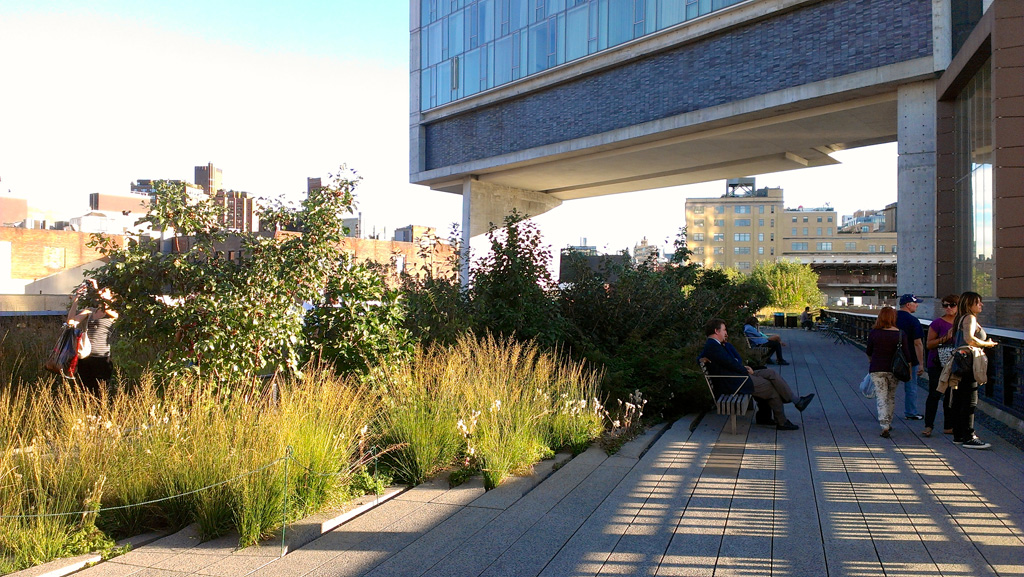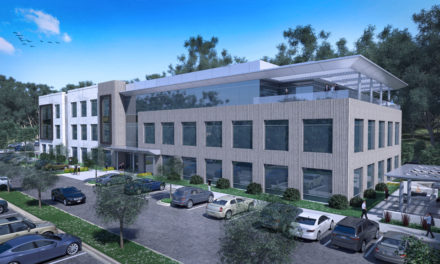In today’s society, sectors across industry are reaping the economic benefits of biophilic design. By examining five of these sectors—workplaces, healthcare, retail stores, schools, and communities—we can begin to understand the fiscal implications of biophilic design across the economy. The numbers and percentages presented reflect powerful evidence that design and planning strategies informed by nature can lead to positive impacts on human health, child development, community safety, and worker satisfaction. These effects translate directly to increased profits.
Driving Profit Margins in the Workplace
The workplace is the crux of progress in modern society; it is where the average US employee spends more than 43 hours per week (US Census Bureau, 2010). Professional and business employers pay on average $41.31 an hour in total compensation per employee, or $85,925 per year—twelve workers alone can cost an employer over $1 million in salary (Bureau of Labor Statistics, 2017). Employers hope their employees are productive every hour, but the proliferation of less than ideal workplace environments, external stimuli, and other factors, makes functioning at 100% efficiency an unlikely scenario. The main causes for deficient productivity include absenteeism, loss of focus, negative mood, and poor health (e.g., Heschong, 2003c). The built environment, though not always the cause of these stressors, can help relieve these undesirable symptoms.
American psychologists have aggregated the five strongest requirements for basic functioning that, if neglected, can trigger worker comprehension problems and dissatisfaction in the office space (Kellert, 2008). These are:
• Need for change (varying temperature, air, light, etc.)
• Ability to act on the environment and see the effects
• Meaningful stimuli (stagnant atmospheres cause an onset of chronic stress)
• One’s own territory to provide safety, an identity, and protection
• View to the outside world
When companies are deciding where to invest internally, the data shows that there is a comparative advantage to invest in their employees. A typical company of 1000 employees, with an average compensation cost per employee of $41.31 per hour, could capture over $5.1 million in economic benefits annually just by increasing its productivity margin as little as 6%. If this company takes measures to retain employees, the cost of employee turnover can also be reduced. The costs of termination, replacement, and the loss in productivity equate to $1,000, $9,000, and $15,875 respectively per employee (Loftness, 2007). This means that losing one employee due to dissatisfaction, illness, or poor work environment could cost the organization $25,875 on average per position, which does not factor in a signing bonus or relocation compensation offered by some companies.
Absenteeism
Absenteeism refers to time employees take off from work, and can include habitual or intentional absence from work. The office environment can play a significant role in supporting or degrading employee health (both physical and psychological), and consequently affect the absenteeism rate. Unnecessary and avoidable absenteeism should not be disregarded financially. In 2010, the US Department of Labor reported an annual absenteeism rate of 3% per employee—or 62.4 hours per year per employee lost—in the private sector. Therefore, an employer will lose on average $2,578 per employee per year to employee absences. Across twenty employees, the same company will lose over $51,000 in salary costs. The number is even more dramatic in the public sector. The reported average absentee rate for the public sector is 4%. With over 83 hours lost to absences each year, an employee’s absence costs $3,437 per year (US Department of Labor, 2010). In a large organization, this translates to millions of dollars lost to absenteeism. Every year, New York City is estimated to lose $4.7 billion due to office worker absences (NYC Economic Development Corporation, 2011; Elzeyadi, 2011; US Department of Labor, 2010). In all sectors, efforts to reduce absenteeism by even a fraction of a percent can yield substantial financial benefits for an organization.
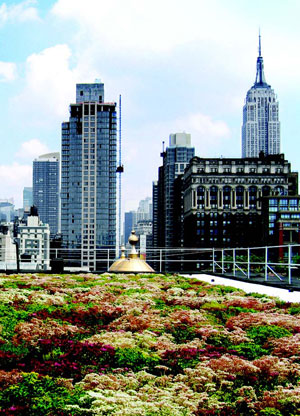
PREDICTING ABSENTEEISM
Elzeyadi’s study at the University of Oregon found that 10% of employee absences could be attributed to architectural elements that did not connect with nature, and that a person’s view was the primary predictor of absenteeism. Features like green roofs can provide excellent views to nature even in commercial, urban settings.
– Green roof at the offices of Cook+Fox Architects and Terrapin Bright Green, NYC, 2010. Photo courtesy of COOKFOX Architects
In order to help reduce absenteeism, offices can use biophilic design strategies to support each of the five fundamental needs of workers (Bergs, 2002). Effective daylighting, natural ventilation strategies, interior greenery, thoughtful spatial configurations, and ample views to nature can, over a period of time, improve employees’ perception of well being, promote health, and reduce absenteeism. Promotion of employee wellness can also translate into significant cost savings. For every dollar spent on wellness, employers save $3.27 on medical costs and $2.73 on absenteeism costs (Baicker et al., 2010). The resulting profit margins contribute to the sustainable growth of successful businesses.
The potential for building design to cut human resources costs is highlighted by a 2011 study of an administrative office building at the University of Oregon (Elzeyadi, 2011). The building is an effective laboratory for testing the biophilia hypothesis: 30% of the offices overlook trees and a manicured landscape to the north and west, 31% overlook a street, building and parking lot to the south and east, and 39% of the offices are on the interior of the building, offering no outside view. When asked to rate scenes according to their preference, the building’s occupants heavily favored the vegetated view over the urban view, and either view over none at all. These preferences did not merely increase or decrease workers’ happiness; researchers found that the quality of employees’ view from their office significantly affected how they behaved at work.
Employees with the view of trees and landscape (north and west) took an average of 57 hours of sick leave per year, compared with 68 hours per year of sick leave taken by employees with no view. When the measure of view quality was combined with those of lighting quality and window area, architectural elements explained 10% of the variation in sick leave days taken. The study found the quality of a person’s view to be the primary predictor of absenteeism. The study also examined where people spent their breaks, and found that employees with better views were likely to spend more time at their desk. Employees with urban views or no views at all were more likely to spend their lunch breaks walking around or in another part of the building. These findings indicate that access to natural scenery is significantly correlated to a person’s job satisfaction, health, and productivity.
Furthermore, studies show that there is a marked difference between peoples’ reactions to natural scenes versus sterile office environments. In a test of 90 participants investigating heart rate recovery from low-level stress, three groups of 30 participants each were exposed to one of three conditions: a glass window with a view to nature, a plasma screen with a high-definition view of the same setting as the glass window, or a curtained wall with no view. The restorative qualities of the view to nature experienced by participants were significantly higher than both the plasma screen and the curtained wall, both of which yielded equally low physiological recovery patterns. The results support Attention Restoration Theory (ART), suggesting that nature promotes recovery from mental fatigue. It also suggests that Nature in the Space enables better focus, mental stamina, and productivity—behaviors that benefit workers and employers alike (Kahn, 2008).
The outcome of this study was not a coincidence; there exists a physiological connection between humans and nature that explains why human attention is neurologically restored. When individuals attempt to focus, there is a neurological restraint that instructs the brain not to be distracted or stimulated by other items or tasks—a function that requires a great deal of energy. Attentional fatigue results in environments where this focus is difficult to achieve, causing stress to slow the heart rate and breathing while simultaneously arousing digestion to raise energy levels. The combination induces lowered concentration and decreased effectiveness (Maas, 2011). This means that we get bored with unstimulating spaces, whereas nature serves as a source of stimuli that renews our attention, reinstating cognitive functioning with natural elements that invoke affective responses.
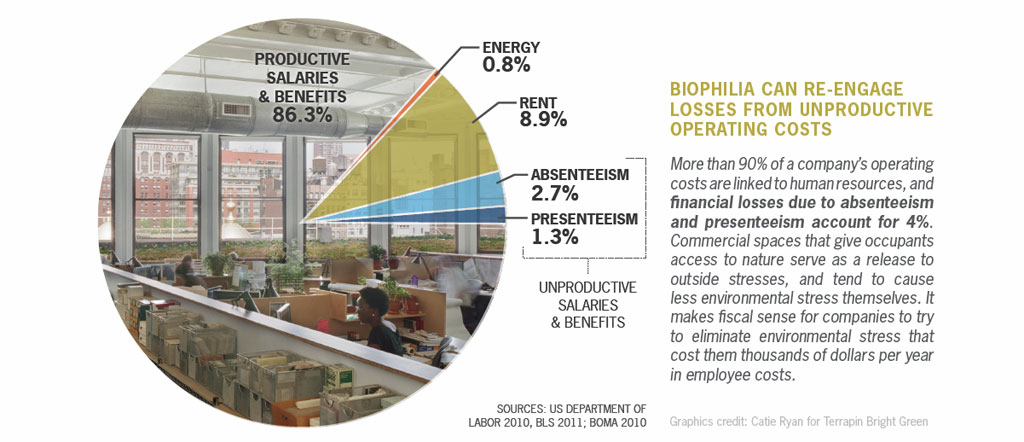
Presenteeism
Health responses to poor indoor environments also have financial implications in the form of “presenteeism.” Presenteeism describes the phenomenon in which employees clock in for work, but are mentally removed from the workplace—consequently underperforming relative to their capacity—causing labor-related financial losses for the company. Workplace-induced presenteeism can result from sleepiness, headaches, stress, and other physiological and psychological discomfort. Presenteeism costs employers in the private sector $938 and employers in the public sector $1,250 per employee per year. For a company with 100 employees, this equates to more than $100,000 lost per year in unproductive time at work.
Biophilic design can combat worker presenteeism by addressing some of the underlying conditions that distract and fatigue workers. Providing access to natural daylighting, outdoor views, and natural ventilation can reduce eyestrain, relieve mental fatigue, and return workers’ attention to their work. Although many studies have focused on the effects of daylighting and views to the outdoors, the integration of plants and greenery into the workplace has also been shown to result in productivity gains and reduced psychological stress (e.g., Bergs, 2002). Green space in an office increases productivity in a range of ways, and increased productivity has a significant impact on overall operating costs.
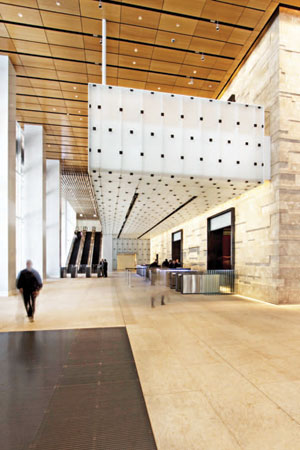
NATURAL ANALOGUES
The Bank of America Tower at One Bryant Park was designed with a focus on biophilia, with the express purpose of attracting and retaining the best employees. The building is extensively daylit, and incorporates natural materials such as wooden floors and ceilings designs, and stone details with a high fossil content.
– Bank of America Tower at One Bryant Park, NYC, 2010. Photo courtesy of COOKFOX Architects
There is precedent for quantifying the economic value of a view to nature. Strategic workstation orientation at the Sacramento Municipal Utility District Call Center revealed surprisingly varied worker performance results (Heschong, 2003c). The number of calls handled per hour by employees with seated access to views of vegetation through large windows from their cubicles far surpassed the number of calls handled per hour by employees with no view of the outdoors. Researchers concluded that those with views of nature handled calls 6%–7% faster than those with no views. The value proposition was clear: With a large number of employees, profit margins grew significantly. The cost to rearranging employee workstations to allow access to natural views totaled approximately $1,000 per employee, whereas the annual productivity savings averaged $2,990 per employee. The initial investment payback was achieved within 4 months, with long-term productivity improvements yielding increased profits. Improved productivity is a benchmark any company can justify and achieve through biophilic workplace planning and design (Heschong, 2003c; Loftness, 2008).
With the proliferation of open-plan offices, noise distraction has become a recognized detriment to worker productivity. A 2005 field study found a 66% drop in productivity due to noise distraction from telephone ringing, office machinery, and coworker conversations (Banbury & Berry, 2005). Another study tested workers on memory and mental arithmetic with and without noise distraction. Accuracy of work was shown to decrease by 67% during exposure to general office noise (Banbury & Berry, 1998). Efforts to limit noise distraction have quantitative benefits to worker productivity. Three independent studies found significant improvements in productivity and mental wellbeing by reducing noise through effective acoustic conditioning in open-plan offices (Lewis et al., 2003, Evans & Johnson, 2000). The studies found a 48% increase in overall focus, 10% greater accuracy, and 27% reduction in symptoms of stress following the acoustic treatment. Biophilic design strategies can be an effective means to absorb, mask, and partition distracting noise. Natural soundscapes, when compared to conventional white noise, have been shown to increase performance on tasks, and improve positive perception of wellbeing in workers (DeLoach et al., 2015).
Supporting sleep quality represents significant opportunity to improve worker productivity. Lacking quantity or quality of sleep has been shown to correlate with increased stress (indicated by raised cortisol levels the following evening) along with physical and mental fatigue (Leproult et al., 1997). Internal circadian rhythms directed by changing light levels and subtle color variation signal the production of sleep-regulating hormones. In order for the body to maintain this function, it must receive ample light of particular color corresponding with particular times of day. Unfortunately, office configurations often disregard this vital physiological process. A study by neuroscientists found that workers located near windows have been shown to sleep on average 46 minutes more per night when compared to windowless offices or workstations far away from windows (Boubekri, 2014). A 2002 field study found workers in daylit offices spent 15% more time working than those in interior, electrically illuminated offices (Figueiro, 2002). Considering an average salary of $85,925, employers could see benefits of over $12,000 per employee per year (Bureau of Labor Statistics, 2017).
From Theory to Practice
In 1978, ING Bank directors shared a vision for their new 538,000 square foot headquarters in Amsterdam. The focus of the building design was to maximize natural lighting, integrate organic art, and install water features to enhance worker productivity and create a new image for the bank. The productivity savings were of notable statistical significance: absenteeism decreased by 15% after construction was completed. Employees reportedly looked forward to coming to work and voluntarily tended to the planted vegetation features in the building (Romm & Browning, 1994). The bank additionally saved an estimated $2.6 million per year after all energy system and daylighting units were installed. At the time, the new headquarters also refreshed ING’s image in Holland as a progressive and creative bank (Romm & Browning, 1994).
The field has progressed considerably since that pioneering example of biophilic workplace design. Enticing financial benefits continue to shift design trends toward creating better workplace experiences. In 2017, the American Society of Interior Designers (ASID) completed a new 8,500 ft² headquarters in Washington, DC. The space features human-centric design elements, including biophilic design strategies. Having conducted a comprehensive pre- and post-occupancy evaluation of their new headquarters, ASID found significant improvements in absenteeism scores (19%), self-reported presenteeism (16%), place attachment scores (69%), and overall productivity (16%). Altogether, the benefits to employee productivity and health had financial returns estimated at $694,000 in just the first year of operation (American Society of Interior Designers, 2018).
Companies across a widening range of industries from technology to manufacturing, have had similar success using their biophilic workplace and green building to entice top prospective employees to join their organization. The Bank of America Tower at One Bryant Park in Manhattan was designed as an iconic building and to ensure that 90% of all employees had views to parks, green roofs and/or rivers, with the explicit purpose of attracting and retaining the best employees. This shift to incorporate nature into workplace design continues as companies see the financial benefits of biophilic workplaces.
“The Economics of Biophilia” is a six-part republication of “The Economics of Biophilic Design” by Terrapin Bright Green. As a series, each section explores one of five economic indicators as it relates to biophilic design: workplace, healthcare, education, retail, and community.
Work References:
American Society of Interior Designers. (2018). Impact of Design Series, Volume 1: ASID HQ Office.” American Society of Interior Designers Research. Washington, DC.
Baicker, K., Cutler, D. & Song, Z. (2010). “Workplace Wellness Programs Can Generate Savings.” Health Affairs, 29(2), 304–11.
Banbury S. and Berry, D. (1998). Disruption of office-related tasks by speech and office noise. British Journal of Psychology 89, 499-517.
Banbury, S.P., Berry, D.C. (2005). “Office noise and employee concentration: identifying causes of disruption and potential improvements.” Ergonomics, 48(1), 25–37.
Bergs, J. A. (2002). “Effect of Healthy Workplaces: Office work, well-being, and productivity.” Green Solar Architecture. Amersfoort, The Netherlands.
Boubekri, M., Chueng, I.N., Reid, K.J., Wang, C. & Zee, P.H. (2014).Impact of Windows and Daylight Exposure on Overall Health and Sleep Quality of Office Workers: A Case-Control Pilot Study. Journal of Clinical Sleep Medicine, 10(6), 603-11.
Bureau of Labor Statistics (2017). Employer Costs for Employee Compensation: Supplementary tables. United States Department of Labor. Washington, DC.
DeLoach, A.G., Carter, J.P., & Braasch, J. (2015). “Tuning the cognitive environment: Sound masking with “natural” sounds in open-plan offices.” Journal of the Acoustical Society of America, 137(4), 2291.
Elzeyadi, I. (2011). “Daylighting-Bias and Biophilia: Quantifying the Impacts of Daylight on Occupants Health.” In: Thought and Leadership in Green Buildings Research. Greenbuild 2011 Proceedings. Washington, DC: USGBC Press.
Evans, G.W. & Johnson, D. (2000). “Stress and open-office noise.” Journal of Applied Psychology, 85(5), 779-783.
Figueiro, M.G., Rea, M.S., Rea, A.C. & Stevens, R.G. (2002). “Daylighting and productivity – A field study.” In Panel 8: Human and Social Dimensions of Energy Use: Understanding Markets and Demand. Rensselaer Polytechnic Institute.
Heschong, L. Heschong Mahone Group. (2003c). “Windows and Offices: A Study of Office Worker Performance and the Indoor Environment.” California Energy Commission: Pacific Gas and Electric Company. Fair Oaks, California.
Kahn, P. H. Jr., Friedman, B., Gill, B., Hagman, J., Severson, R. L., Freier, N. G., Feldman, E. N., Carrere, S. & Stolyar, A. (2008). “A plasma display window?—The shifting baseline problem in a technologically mediated natural world.” Elsevier Science Ltd., Journal of Environmental Psychology, 28, 192–199.
Kellert, S., Heerwagen, J. H., & Mador, M. (2008). Biophilic Design. Hoboken, New Jersey: John Wiley & Sons, Inc.
Leproult R, Copinschi G, Buxton O, Van Cauter E. (1997). Sleep loss results in an elevation of cortisol levels the next evening. Sleep, 20, 865–70.
Lewis, E. Lemieux, P., Sykes, D., Horrall, T. & Dowell, B. (2003). “Reducing noise distraction to increase worker productivity.” Summary of a 4 -month laboratory study published by Herman Miller, Inc.
Lewis, E., Lemieux, P. & Sykes, D. (2003). “Using a web-based test to measure the impact of noise on knowledge workers’ productivity.” Paper published in the proceedings of the HFES 47th Annual Meeting, Denver, CO.
Loftness, V. (2008). “Sustainable Design for Health & Productivity.” Center for Building Performance & Diagnostics.
Loftness, V., Hartkopt, V. & Gurtekin, B. (2007). “Building Investment Decision Support (BIDSTM).” Carnegie Mellon University Center for Building Performance and Diagnostics. Pittsburg, PA.
Maas, J. (2011). “Take a hike! How attention restoration theory shows that nature sharpens the mind.” Ode for Intelligent Optimists, 8(4).
NYC Economic Development Corporation. (2011). “NYC At-A-Glance, 2011 Update.”
Romm, J.J., & Browning, W. D. (1994). “Greening the Building and the Bottom Line.” Rocky Mountain Institute. Snowmass, Colorado.
US Census Bureau. (2010). Current Population Survey, Annual Social and Economic Supplement. Washington, D.C.
US Department of Labor. (2010). “Absences from work of employed full-time wage and salary.” Washington, D.C.
Appendix: Worker Productivity
New York City’s Gross City Product (NYC GCP) is about $540 billion annually (New York City At-A-Glance, 2011 Update). Of that amount, we estimated the amount that is produced by workers in office environments. We assumed that workers in the finance, insurance, real estate, information, and other professional and business services categories generally work in office buildings. Those categories of the NYC GCP add up to approximately $157 billion. While a small number of the salaries earned in those sectors may not be in office environments, this estimate is almost certainly a low estimate of the portion of the city’s salaries earned in offices, as we left out all employees in the health care sector, government, and other categories that employ many people in offices. Private firms experience an absenteeism rate of about 3% (US Department of Labor, 2010). Multiplying by our conservative estimate of the portion of NYC GCP earned in office environments, we calculated that the lost productivity value of absent employees who work in office buildings in New York City is about $4.7 billion. Studies have shown that biophilic work environments can reduce about 10% of workers’ absenteeism (Elzeyadi, 2011). Therefore, biophilic work environments could help New York City recoup $470 million in reduced absenteeism.

